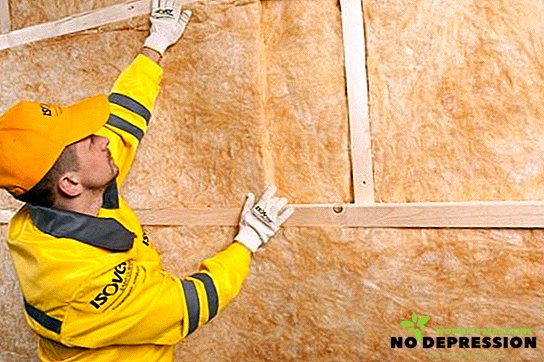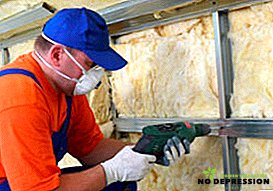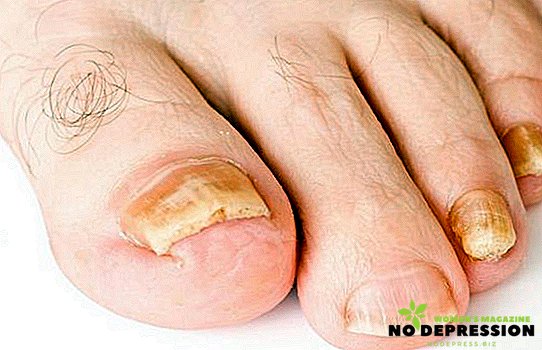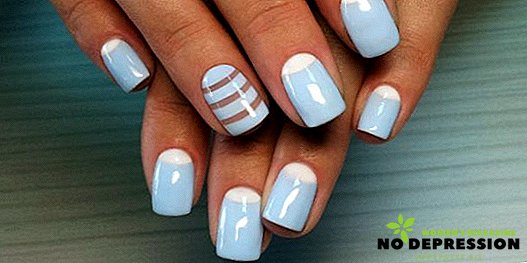Deciding to insulate the walls in the house or apartment, you must carefully select the material. Your expenses and the comfort of living will depend on it.

What to choose - internal or external insulation?
The choice between external and internal insulation should definitely be taken in favor of the first. From a physical point of view, it is designated by the term insulation, and internal insulation is rather a “cut-off” of walls from contact with moist and warm air.
If the insulation is located outside, the wall receives heat from the inside, thanks to which it cools less, does not have a temperature that contributes to the condensation of vapor. With the internal location of the insulation becomes an obstacle that does not let the heat outside. At the same time, it can cool almost to the full equalization of temperatures on both sides, loses its thermal insulation characteristics and remains only a mechanical barrier to external influence.
Internal warming is done for two reasons:
- in addition to the outside;
- if it is impossible to perform work outside, for example, technical conditions do not allow, there is no access and so on.
If there is no other way out and only work inside is possible, you must first find out the causes of condensate and eliminate them.
Comparison of materials: what to choose for wall insulation?
Styrofoam (or foam)
It is the most common type of insulation, which is obtained through the polymerization of styrene. It is heated and whipped under the influence of a gas-forming substance. The resulting granules can be poured into the floor, but in most cases, ready-made pressed blocks or plates are used.
Styrofoam has excellent thermal insulation properties, it practically does not absorb moisture. At its application it will not be necessary to construct a timbering and to carry out additional works on vapor barrier of walls. PPP is undemanding during operation, and with proper installation retains its properties for several decades. Also attracts and its low cost.
But the choice of material for wall insulation inside the house should be approached very responsibly, and the low price should not prevail over the quality in this matter. PPS has many shortcomings that are not so important for the insulation of walls inside non-residential premises, but for apartments and houses they can be a serious danger.
The disadvantages include:
- The combustibility of the material - when burning, it emits toxic substances that can be dangerous to humans.
- PPP is a fragile and easily breakable material.
- Almost in 100% of cases, rodents are established in the faculty, which equip their burrows there. This not only causes the destruction of insulation, but also leads to the need to use special chemicals.

Extruded polystyrene foam
It can also be used for wall insulation from the inside. The material is a rigid slab made of polystyrene granules. It is a universal insulation that can be used for insulation of walls, basements, rooms with high humidity.
The material has a low level of thermal conductivity, almost does not absorb moisture. He is also not afraid of exposure to the environment, such as precipitation, temperature extremes. However, extruded polystyrene can ignite when heated, but does not emit harmful substances. Despite all the advantages, this material has low vapor permeability, which can cause a poor microclimate in the rooms.
Therefore, when choosing this material, it is necessary to provide a ventilation system. With prolonged exposure to direct sunlight, the EPS also collapses and loses its heat-conducting properties. The life of the material is about 30 years.

Mineral wool
Excellent material for wall insulation inside and out. Available in the form of rolls or plates of different density, on which both the cost of the material and its thermal insulation properties depend. Rolled material is ideal for wall insulation, floor and ceiling is better to use plates.
The advantages of mineral wool include:
- retains heat well in the winter; in the summer, it protects from overheating;
- possesses good sound reflecting properties;
- belong to non-combustible materials, in contact with fire does not emit toxic substances and does not form smoke.
But there are also disadvantages:
- The declared safety of the mineral wool is very conditional. In the manufacture of this material is used a binder that releases finol.
- Working with mineral wool is not as dangerous as with fiberglass, but also requires the use of protective equipment. When warming walls indoors, it is better to use basalt wool of super thin fiber, since there are no binders in the composition of such material.
- After laying the insulation from above it is covered with a vapor barrier film that protects the material from condensation, and the room from small particles of insulation.

Glass wool
It is considered one of the most famous materials, but in recent years, the popularity of glass wool falls due to the emergence of more modern heaters. A heater is made on the basis of glass waste, the material is wide fibers up to 5 cm long. The advantages include:
- High elasticity. For storage, glass wool can be pressed, and if necessary, the material will quickly take on its original size.
- High vibration resistance.
- Not toxic.
- High heat and sound insulation properties.
- Fireproof.
- The material is not afraid of fungi, mold, pests.
But there are also disadvantages:
- lower operational period in comparison with other materials;
- in some types of insulation may contain formaldehyde;
- when working with glass wool, it is necessary to protect the body and face with special equipment.
It is necessary to dwell upon the last drawback.
If you neglect the precautions when applying glass wool, it can get on the skin, which will cause severe itching.
And if small particles get into the airways, there is a risk of serious illness. All clothing and respirator after work should be thrown out. However, this disadvantage is compensated by a combination of high thermal insulation properties and low prices.

Ecowool
Lightweight cellulose based material. It is characterized by a loose structure. Ecowool has wood fiber, boron and boric acid, which act as antiseptics. The advantages of ecowool include:
- Environmentally friendly material. All components in the composition are of natural origin, safe for humans and nature. Due to this, ecowool was entered into the register of natural and safe materials. In addition, in case of fire, the material does not emit toxic substances.
- Good thermal insulation characteristics. This is due to the low level of air permeability, thermal conductivity, and also due to the fine fiber structure of the material. As practice shows, the heat-conducting properties of ecowool do not decrease with the passage of time, and it is not inferior in quality of insulation to such insulation as mineral wool, wooden beam, foam concrete, and so on.
- Not afraid of corrosion. Ecowool is ideal for insulating metal structures, as it does not provoke the appearance of rust.
- No shrinkage. Due to the elasticity and elasticity of the fibers, this insulation does not shrink even when arranging vertical structures. This is a significant advantage over many wadded insulation.
- High-quality sound insulation, which is much higher than that of the mineral wool. So, a layer of ecowool with a thickness of 5 cm can absorb noise up to 63 dB. Therefore, when using eco wool for insulation of walls, floor, interfloor floors, you can achieve good results.
- Speed of installation. Ecowool is sprayed with a special vacuum cleaner. This will create a seamless coating, as all the cracks and hard-to-reach places are filled. A specialist can cope with the warming of a house with an area of 100 squares in just two days.
- Moisture resistance and vapor permeability. The material accumulates as well as gives moisture, while not losing its insulating characteristics. However, despite the assurances of manufacturers, it is necessary to use vapor barrier.
- Biostability Due to the content of antiseptics in the composition of this insulation is resistant to microorganisms, successfully protecting the house from rotting, destruction. Also boron compounds present in the composition are detrimental to rodents and pests.
- Fire resistance Ecowool is not afraid of fire: does not smolder, does not melt.
But there are also disadvantages:
- It is necessary to entrust the work to a professional, which may cause a rise in the cost of work. But at the same time, the service life of the material depends on the quality of the insulation.
- Do not lay ecowool near the chimney, fireplace or incandescent pipes. Under the influence of high temperatures, the material may start to smolder.

Liquid ceramic insulation
This is a very thin thermal insulation, in the composition of which there is an acrylic binder, additives, anti-corrosion and antifungal components. The result is a water-resistant material that is resistant to external influences. Externally, the liquid ceramic insulation resembles paint, which makes it possible to apply it to any surface with a brush, roller or spray gun.
Thickness of a layer of 1 mm is equivalent in characteristics to a layer of mineral wool 50 mm thick. Liquid insulation can withstand temperatures from -60 to +250 degrees, without changing its performance characteristics. Also, when choosing this material does not need to carry out additional work on the vapor barrier and waterproofing. Service life - 20-30 years.
The advantages include:
- the possibility of applying to any materials;
- protection of the wall from moisture;
- easy application;
- reduction of heat loss of the room;
- ease of repair if necessary;
- environmental friendliness and safety for health;
- lack of shelter for pests;
- application is possible at -20 degrees;
- no load on the walls.
The only disadvantage is the relatively high cost of this heater.

Cork wallpaper
Ecologically safe material which at the same time is both a heater for walls, and a decorative covering. However, despite the many assurances of manufacturers, a thin layer of such wallpaper is not effective enough.

Polystyrene wallpaper
With their help, you can also insulate the walls from the inside, mask small defects on the surface. This method is most rational when the apartment is insulated, when it is not possible to install external insulation. The thickness of the wallpaper can be from 3 to 6 mm, which means that they do not "steal" living space. They are glued as usual wallpaper on a special glue.
The advantages include:
- excellent thermal insulation properties: a layer of wallpaper with a thickness of 6 mm is equivalent to brickwork with a thickness of 12.5 cm;
- high level of noise insulation;
- moisture resistance that allows you to protect the walls from mold;
- no unpleasant smell;
- safe for health, because they do not have freon or butane.
The disadvantages include the flammability of the material, as well as the fact that pasting walls with similar wallpaper shifts the dew point toward the room.
How to avoid problems with internal warming?
To avoid problems of internal warming, it is necessary to determine the location of the dew point. Ideally, it should be located either inside the wall or inside the insulation, which is somewhat worse. If the dew point is on the border of the two materials, then sooner or later condensate will begin to appear, which will penetrate through the side walls, insulation, leaking vapor barrier sections, and so on.
This situation is also possible with low vapor permeability of the material or with a large thickness of insulation. To resolve this issue, there are several recommendations that should be followed:
 It is not recommended to use insulation with a layer thicker than 50 mm.
It is not recommended to use insulation with a layer thicker than 50 mm.- Choose only vapor-proof material that can form the most airtight layer.
- Ventilate the room. Removal of air saturated with steam will reduce the pressure and intensity of the impact of steam on the walls and insulation.
- When installing insulation work carefully, do not create cracks, do not skip areas. It is especially important to work closely on the window opening in the areas of slopes, window sill, upper cut. The side walls can also become a source of steam - ideally, it is recommended to isolate the entire room, but this is not always possible.
If you want to avoid steam load, prime all surfaces with special compounds that reduce vapor permeability through the material. This is a particularly important stage when working with loose porous materials.
Do I need a vapor barrier?
The need for internal vapor barrier is obvious. The whole point of internal warming is the creation of a tight boundary between walls and saturated air vapor. Even if the heater itself is a good steam insulator, then a separate layer of vapor barrier is not necessary, especially in the presence of supply and exhaust ventilation.
However, in order to insure themselves against possible microscopic cracks, gaps and other cavities in the insulation, an additional layer of vapor barrier is often installed to cut off adjacent walls. But if friable materials that can pass steam are used as insulation, then you cannot do without full vapor barrier for walls.
Deciding to save, you will reduce all your work and efforts "to nothing". The material will get wet, condensate about the soaked insulation, because of what he will cease to retain heat and simply will accumulate moisture. As a result, the walls will get wet, frost, and collapse.


 It is not recommended to use insulation with a layer thicker than 50 mm.
It is not recommended to use insulation with a layer thicker than 50 mm.









